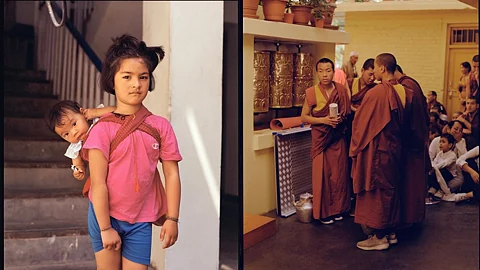
- HOMEGROWN WORLD
- #HGCREATORS
- #HGEXPLORE
- #HGVOICES
- #HGSHOP
- CAREERS
- ABOUT US
- CONTACT US

In recent years, Tenzin Lhagyal has emerged as one of India's most promising fashion photographers with his polished editorials for Eka, AR by Rhea Kapoor, and features in prestigious magazines like Vogue India and Elle. But while his commercial work is crisp, composed, and deeply attuned to contemporary style, his personal work focuses on a very different subject: the Tibetan community in Dharamshala.
Born and raised in Himachal Pradesh to Tibetan refugee parents, Lhagyal is part of a generation of exiles — Tibetans born in India but legally unrecognised as Indian citizens. More than 60 years after the Dalai Lama's escape from Tibet in 1959, the Tibetan refugee population in India, now in its third generation, remains in a state of political limbo. They are allowed to live, study, and work in India, but often without full citizenship rights, voting access, or the protections of nationality. For many, home is both here and elsewhere — it represents a state of permanent in-betweenness.
"My parents came to India from Tibet in 1992," Lhagyal says. "Like many Tibetan dissidents fleeing Chinese repression, they made the journey by foot and walked for days to reach the border."
In his personal work, Lhagyal doesn't sensationalise or romanticise this narrative. There's no overt political messaging or dramatic framing in his photographs. Instead, his personal work reflects an observational approach, akin to documentary portraiture. In doing so, he avoids turning his subjects into symbols, offering them space to simply exist. This restraint is what gives his images their poignancy. These quieter images of longing, displacement, and collective memories, of young children, monks in prayer and ceremonial stillness — both real and imagined, factual and fictional — form the core of Lhagyal's personal body of work. They carry the weight of exile and speak of a culture preserved through routine and rituals, even as its future remains in limbo.
Lhagyal calls this body of work 'Norbu Tsering'. "It means 'long live, my jewel'," he says. "It's how we greet and say goodbye to loved ones."
And yet, the very act of simply showing Tibetan life with dignity is political in itself. To photograph a people often made invisible by history and geography — and to do so without spectacle — is an undeniably important act of reclamation. In placing this work alongside his commercial practice, Lhagyal makes a subtle but powerful statement: that fashion, beauty, and tradition can coexist with displacement and longing, and that identity is never just one thing.
His images suggest that the Tibetan story — a story of survival without sovereignty — deserves to be seen not just in the context of protest, but in everyday, ordinary moments of grace, reflection, and resilience. Through his two-fold practice, Lhagyal shows is that fashion and exile, as well as aspiration and memory, can coexist, held together by the time-stopping stillness of the photographic medium.
If you enjoyed reading this, here's more from Homegrown:
Pure Street Photography Is A Homegrown Platform That's Nurturing The Art Form Globally
What Makes You Stay?: The Layered Storytelling In Tanmay Saxena's Photography
Spandita Malik's Radical Khadi Portraits Centre The Stories Of Domestic Abuse Survivors
